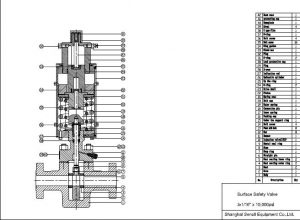Surface Safety Valve operation manual point
Surface Safety Valve (SSV) is one kind of emergency shut down valve which is popular adopted in high pressure pipeline. Normally, its working pressure is from 5,000psi to 20,000psi. SSV is normally working cooperated with ESD control panel which will control SSV actuator. Below is some important point for manual and maintenance.
- Technical Specification
Nominal diameter: 3-1/16”
Working pressure: 10,000 psi
End Connection: 3-1/16” x 10,000 psi
Overall size: 1360 x 619 x 270mm
Actuator type: hydraulic
- Installation key point
- SSV must be installed according to assembly diagram.
- Parts should be cleaned before installation.
- Pressure Test key point
- Body test
Valve should be half open. Test pressure should be 1.5 times of working pressure. There should be no leakage or sweating.
- Hydrostatic seal test
Valve should be fully open. And charge pressure from both sides in turn. There should be no leakage or sweating.
- According to product specification level, test request is different as below form.
| Test method | PSL | Holding Time | ||
| First | Second | Third | ||
| Body test | PSL1 | 3 mins | 3 mins | – |
| PSL2 | 3 mins | 3 mins | – | |
| PSL3 | 3 mins | 15mins | – | |
| Hydrostatic seal test | PSL1 | 3 mins | 3 mins | – |
| PSL2 | 3 mins | 3 mins | 3 mins | |
| PSL3 | 3 mins | 15mins | 15mins | |
- Drift test
For API 6A valve, it should pass drift test.
- Operation point
- Only products which pass pressure test can be adopted online.
- Relief valve should only be used for emergency shutdown on the ground, in a fully open position during normal
- During the normal work, protective cap should be locked.
- Maintenance Point
- Regular maintenance can prolong service life of SSV.
- Check the tightness of fasteners and in good condition, if any, should be replaced in a timely manner.
- Check bonnet bolts in every 3-4 months.
- If stand by, SSV should be stored in dry and ventilated place to avoid rust.
- G. A drawing.


Leave A Comment